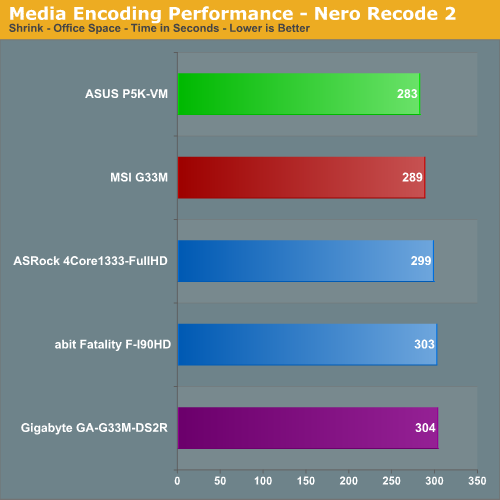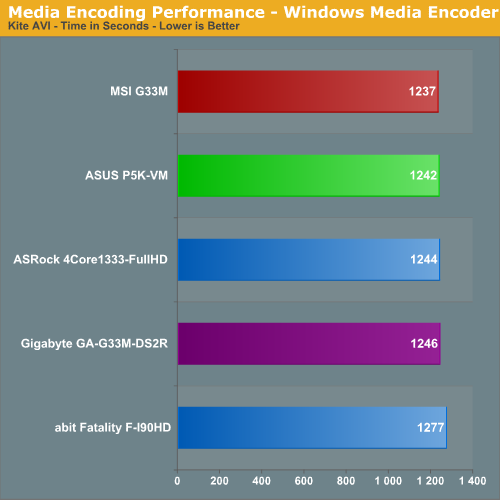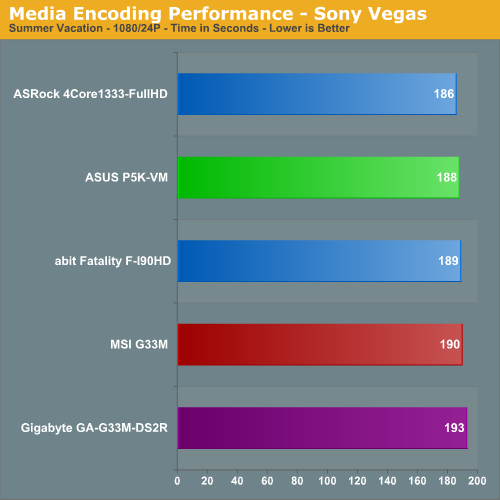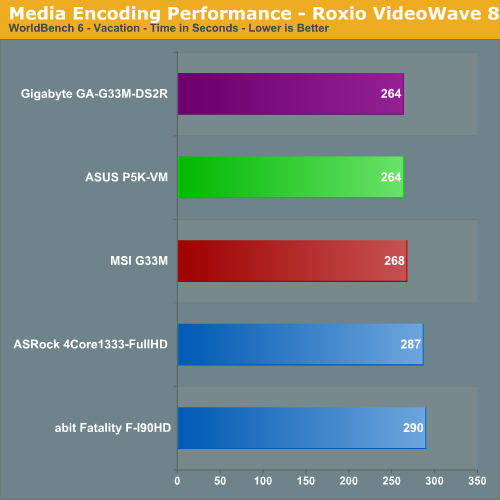µATX Part 2: Intel G33 Performance Review
by Gary Key on September 27, 2007 3:00 AM EST- Posted in
- Motherboards
Media Encoding Performance
We are utilizing an updated video encoding test suite for this article that includes Nero Recode 2, Windows Media Encoder 9, Sony Vegas 7.0e, and Roxio VideoWave 8. The scores reported include the full encoding process and is represented in seconds, with lower numbers providing better performance.
Our first series of tests is quite easy - we take our original Office Space DVD and use AnyDVD to rip the full DVD to the hard drive without compression, thus providing an almost exact duplicate of the DVD. We then fired up Nero Recode 2, selected our Office Space copy on the hard drive, and performed a shrink operation to allow the entire movie along with extras to fit on a single 4.5GB DVD disc. We left all options on their defaults except we checked off the advanced analysis option.

The results are fairly indicative of what we will see in our application testing. The G33 boards will generally fare a little better in CPU or memory sensitive tests due to their latency and memory throughput advantages although our Gigabyte board tends be slightly slower than the other G33 boards when it comes to storage system results. In this test, the ASUS P5K-VM finishes first and is around 7% quicker than the Gigabyte board.
Our next test has us converting our day at the beach AVI file into a high definition WMV file suitable for our Aunt Gertrude to view on her new high definition LCD TV. We ensured our quality settings were set to High Definition. The balance of options is set to standard settings and then we let this program do its magic.

Our MSI board finishes this grueling task first and is 3% quicker than the last place board. While CPU performance is very important in this test, a good storage system is a must during this particular conversion. We see the Gigabyte board finishing behind our other two G33 boards and attribute most of this to the storage system performance not being up to par.
Our Sony Vegas 7.0e test converts several of our summer vacation files into one plasma screen pleasing 1080/24P format with a 5.1 audio stream. We ensured our quality settings were set to their highest levels and then let the horses loose.

In a test that really stresses the CPU, we see the ASRock X1250 board is about 4% faster than the Gigabyte G33 based board with the ASUS board finishing a couple of seconds faster than the MSI board.
Next on the list is our Roxio VideoWave 8 test from the PC WorldBench 6.0 test suite that does a short contemplation of video vacation shorts into a final movie.

The Gigabyte G33 board finishes first and is about 9% quicker than our X1250 boards in a test that really stresses CPU throughput with less emphasis placed on the storage system. Both X1250 boards make up a second place tier of performance in this benchmark.
We are utilizing an updated video encoding test suite for this article that includes Nero Recode 2, Windows Media Encoder 9, Sony Vegas 7.0e, and Roxio VideoWave 8. The scores reported include the full encoding process and is represented in seconds, with lower numbers providing better performance.
Our first series of tests is quite easy - we take our original Office Space DVD and use AnyDVD to rip the full DVD to the hard drive without compression, thus providing an almost exact duplicate of the DVD. We then fired up Nero Recode 2, selected our Office Space copy on the hard drive, and performed a shrink operation to allow the entire movie along with extras to fit on a single 4.5GB DVD disc. We left all options on their defaults except we checked off the advanced analysis option.

The results are fairly indicative of what we will see in our application testing. The G33 boards will generally fare a little better in CPU or memory sensitive tests due to their latency and memory throughput advantages although our Gigabyte board tends be slightly slower than the other G33 boards when it comes to storage system results. In this test, the ASUS P5K-VM finishes first and is around 7% quicker than the Gigabyte board.
Our next test has us converting our day at the beach AVI file into a high definition WMV file suitable for our Aunt Gertrude to view on her new high definition LCD TV. We ensured our quality settings were set to High Definition. The balance of options is set to standard settings and then we let this program do its magic.

Our MSI board finishes this grueling task first and is 3% quicker than the last place board. While CPU performance is very important in this test, a good storage system is a must during this particular conversion. We see the Gigabyte board finishing behind our other two G33 boards and attribute most of this to the storage system performance not being up to par.
Our Sony Vegas 7.0e test converts several of our summer vacation files into one plasma screen pleasing 1080/24P format with a 5.1 audio stream. We ensured our quality settings were set to their highest levels and then let the horses loose.

In a test that really stresses the CPU, we see the ASRock X1250 board is about 4% faster than the Gigabyte G33 based board with the ASUS board finishing a couple of seconds faster than the MSI board.
Next on the list is our Roxio VideoWave 8 test from the PC WorldBench 6.0 test suite that does a short contemplation of video vacation shorts into a final movie.

The Gigabyte G33 board finishes first and is about 9% quicker than our X1250 boards in a test that really stresses CPU throughput with less emphasis placed on the storage system. Both X1250 boards make up a second place tier of performance in this benchmark.










26 Comments
View All Comments
sprockkets - Friday, September 28, 2007 - link
Sad how an AMD 7050 board can be had for $80, $40 cheaper with the same features. It is the premium you pay for having dvi.Oddly enough too is that the Gigabyte board you quote doesn't use all solid caps yet the lower end board does. And of course, they didn't bother with solid caps on their new AMD boards period, cause "AMD is second tier."
tayhimself - Thursday, September 27, 2007 - link
Preposterous!! Why do they even bother making this junk without DVI. More and more I find that I don't want a leet board that overclocks 100 Mhz higher but a stable board with the right features. -sigh-8steve8 - Thursday, September 27, 2007 - link
and on top of it, these igp's are not suited well for gaming or videos,,, (the two applications where you may not notice the difference between a digital and analog interface), so they will be used for text/office work... an application where the discrepancies in the user-experience of analog vs digital interfaces with an LCD are undeniable.again, great article.,, but in the end, I sort of wonder why waste ur time exploring these boards when your time is better spent on solutions that deserve our money?
JarredWalton - Thursday, September 27, 2007 - link
I think both of those G33 + SDVO models launched long after Gary had started work on this uATX stuff. Good to see that some people are including the necessary chip, as uATX without DVI is simply unacceptable. Unfortunately, testing some of this stuff takes a lot more time than we would like. We're working to address that, however.jenli - Thursday, September 27, 2007 - link
I would love to see a review of motherboards with igpthat can be converted to raid servers by using the lone
pcie 16x slot.
Have fun,
CK804 - Thursday, September 27, 2007 - link
I'm doing exactly what you mention with an Intel DG965RY. I have an Areca ARC-1210 fitted in there with 3 320GB WD Caviar SE16s in RAID 5.